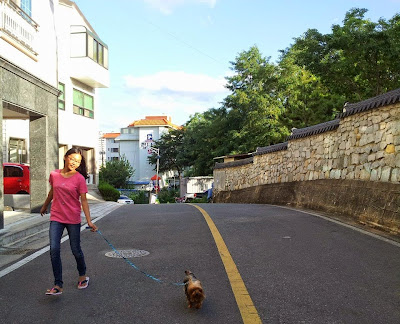They call it Gwangbokjeol (광복절) – that sweet moment of liberation from the pillage of war, and from the ruthless grasp of the Japanese colonial rule. Literally, it means “the day the light returned”, especially for many imprisoned independence activists who were freed on that momentous day 70 years ago.
Korean independence activists who were released from prison
on August 15, 1945 (photo from wikipedia)
A special tradition has been made since then - granting special pardon to convicts of petty crimes. This year, President Park Geun Hye gave reprieve to 6,527 prisoners, a day ahead of the celebration, to “help forge national reconciliation and revitalize the economy, as well as boost people’s spirits”.
That was a line enough to boost everyone’s spirits, so we headed out to get a feel of the gwangbokjeol. And we saw it right away on the streets, buses, subway and monorail trains, and on buildings. Korean flags or the taekgukki - symbol of national pride dangled everywhere.
That day, all roads led to Suseongmot. Throngs jammed the trains and buses like huddles of bees. It was probably the first time the monorail – a magnetic levitation (or Maglev) train and Daegu’s newest addition to its dynamic transport system – has served such a massive crowd.
The new monorail train en route to Suseongmot.
People pitched tents and spread picnic mats to watch shows and concerts held around Suseongmot. Some simply came early to secure a perfect spot to get a good view of the fireworks display.
Children had their share of entertainment as well, on a swimming pool filled with floating plastic balls. Kids were also made to practice manipulating fire extinguishers - a basic life-saving skill most adults forget to teach children.
Kids learning how to operate fire extinguishers.
Under the shade of a tree, we saw an elderly group, around seventy or eighty years of age, watching with delight a performance on stage – a dance accompanied by an upbeat Korean music. These generations of Koreans have lived the horrors of war, and perhaps, have a family member – a father, a grandfather, an uncle, or a brother - who went to battle and never came back. The loved ones they lost have never seen the light return to their homeland, but their hard work restored it.
It was a day of collective memory, for a country where history is never forgotten. People came to celebrate freedom, contemplating on their ancestors’ battle for independence and on those who have died fighting for it.
The taekgukki bears the Korean pride
on Gwangbokjeol (photo from Koreabridge)
The day was marked not just with animated spirits celebrating that momentous day in August of 1945, but with a vibrant air of fierce nationalism as well. That part of them will ensure that the light their ancestors restored for them stays on.































